As I drove over the West Seattle Bridge last week, Mt. Rainier wore a bank of clouds like a mourning cloak. I had just learned that particulates from car tires washing into streams are likely responsible for mysterious Coho salmon die-offs around the Sound. As my guilty wheels inched along, I mentally apologized to the mountain, steadfast witness to our interconnectedness.
Later that day, Greg Rabourn, King County Watershed Steward for Vashon-Maury, gave me an encouraging perspective—a way that human action is effecting positive change for salmon.
“We’re really fortunate to be in a position where we can actually contribute to Chinook salmon and Orca recovery right here on our island—we don’t have to sit back and wait for other projects, we have homegrown projects happening now,” he said.
Rabourn, who has been involved in salmon habitat recovery for 20 years, was referring to BeachNET, Vashon Nature Center’s (VNC) Beach Nearshore Ecology Team, a network of scientists and citizens who monitor the health of our beaches in a variety of ways. So far this year, island volunteers have spent 364 hours collecting data related to forage fish on island beaches!
Last month, the length of our natural shoreline grew by more than 650 feet thanks to a multiagency effort spearheaded by Rabourn that took years to complete. (The project received monies from the Estuary and Salmon Restoration Program and other salmon recovery funding.) Four new sections of armoring (bulkheads) were removed from properties around Quartermaster Harbor—providing BeachNET volunteers with new beaches to study.
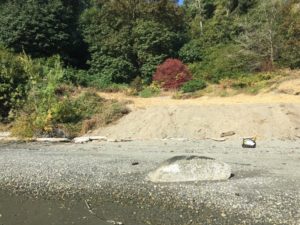
After: New beach begins to form after a house and bulkhead were removed at a property near Lost Lake earlier this month as part of a project to restore forage fish spawning habitat. Photo by Maria Metler.
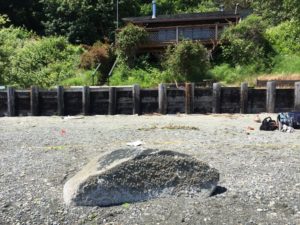
Before: A house and bulkhead at a property near Lost Lake before armoring removal. Photo by Maria Metler.
“If we remove what’s impeding the natural functions of the shoreline, good things happen for wildlife,” Rabourn says. “We hope to improve habitat for the forage fish salmon eat that spawn on these beaches.”
The majority of unarmored shoreline in King County is on Vashon and Maury. Central Puget Sound mainland shoreline is 80 percent armored, compared to our 50 percent. Since 2011, King County has collaborated with other agencies to remove 1,425 feet of island shoreline armoring, and Rabourn is on track to reach 2,000 feet by 2020.
Salmon health linked to natural beaches
Vashon-Maury beaches are a critical regional resource because they attract salmon from all over Puget Sound that feed and find respite along our healthy shorelines. This is especially true for Chinook—an endangered species that travels far from its spawning beds to feed and grow along Salish Sea shores. Juvenile Chinook from as far away as the Stillaguamish River have been found along our island beaches. Juvenile Chum and Coho also use the Vashon-Maury shoreline for food and as a shallow-water refuge from deeper water predators.
“Our BeachNET surveys explore how long it takes to start seeing changes at these restoration areas and record what those changes are,” says Bianca Perla, director of VNC. “For example, we’re monitoring for insect fallout because the terrestrial insect population provides food for salmon that forage along our shores. We are measuring how long it takes for driftwood to return to these sites because it provides nooks and crannies where little fish can hide from bigger fish at high tide, and food for them in the form of invertebrates breaking down the wood.”
In preliminary analysis of three years of BeachNET forage fish data comparing sites with and without armoring, on unimpeded beaches there is more overhanging tree canopy, a higher proportion of native plants, and higher numbers of the native flies that salmon prefer to eat. There is also higher coverage of beach wrack (the flotsam and jetsam washed up from the tides that contains rich nutrients and food for many beach invertebrates), and more logs on sites without bulkheads.
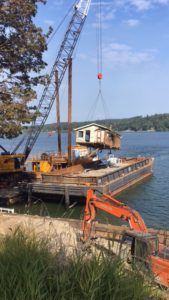
Earlier this month, this house was removed on Quartermaster Harbor as part of an ongoing effort to create more natural beaches to benefit salmon. Photo by Cindy Young.
“Removing bulkheads makes more room for the forage fish to spawn and adapt to climate change, so as sea levels rise they won’t be squeezed out,” Perla says. “Without a bulkhead, the beach will shift back with rising sea levels, allowing fish the narrow band of beach that they can successfully use to spawn where eggs won’t drown or become desiccated.”
A Sound-wide effort
“The goal of removing armoring is to re-establish the intertidal beach, so that there is no interruption between land and water,” says Jason Toft, research scientist with the University of Washington School of Aquatic and Fishery Sciences. “Monitoring of shorelines can help measure how effective these efforts are. We have a great collaboration with VNC and many other citizen science groups around Puget Sound, who are using the same tools to gather data.”
Toft helped develop the Shoreline Monitoring Toolbox, a set of standardized protocols for measuring beach health used by BeachNET volunteers. VNC’s work plugs into a Puget-Sound-wide effort to monitor armored and unarmored sites, which will help scientists like Toft learn more about what helps salmon thrive and how humans can contribute to their improved health.
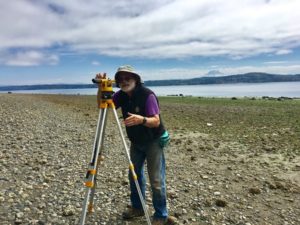
BeachNET volunteer Hooper Havekotte surveys a beach as part of a bulkhead removal monitoring study. Photo by Bianca Perla.
“It’s often hard to find funding to monitor restoration projects because it takes a lot of time and people power—that’s where VNC comes in,” Perla says. “Our purpose is to help natural resource managers learn from their efforts and increase their successes. The aim is to help everybody learn how to best take care of Puget Sound. We are on a race against time as salmon populations are declining in a food chain affecting sea birds and Orcas.”
Rabourn reports that just a few days after the armoring was removed there was more sand on the newly freed beaches.
“On a community level, I’m excited that islanders are helping monitor this restoration,” Perla says. “When you’re looking at the beach through a science eye you learn so much more about the habitat and who lives there, and that’s a really bonding experience. This work helps us build a positive relationship with our home and that’s what we need more of to improve the health of the Salish Sea.”
Thinking back to my feelings of despair on that freeway bridge, I know volunteering for Vashon Nature Center will not erase the impact of my polluting tires. But this work strengthens my connection to the salmon, the Sound and the mountain.
Hit the Beach: BeachNET welcomes new volunteers and requires only a three-hour commitment per beach survey. To join a forage fish survey and explore the island’s newest beaches, contact Maria Metler.

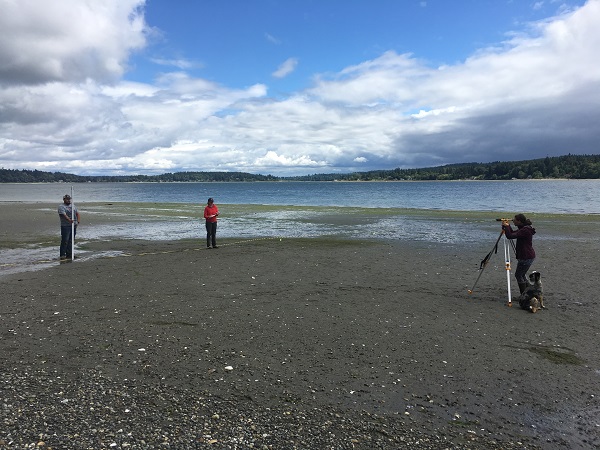
Of course I support any effort to increase the possibility of returning salmon to our waters. But I think SAND could eventually fill our harbor, making it more shallow. I now see a build up of sand at the isthmus. I have watched the sand move north each year on the Maury side for 60 years. Monies spent should be focused on waterfront areas which are most beneficial for salmon retur (springs, wetlands such as Lost Lake) rather than areas such as the southeastern side of Maury where there were no wetlands above the bulkhead which was removed at a large expense. Where sand is eventually deposited hasn’t been considered in previous years in my opinion. Will it wipe out other eelgrass beds inside Quartermaster?
Hi Patty, thanks for your reply and thoughts. Sources of sand into Qmaster include both beaches and major creek deltas like Judd Creek and Fisher. The coastal atlas shows current patterns called drift cells along Vashon and Maury which can help predict where sand ends up. Actually from an island perspective the most important habitat we have for conserving salmon populations is our shorelines. Young salmon from as far away as the Snohomish River forage along our shores. In addition we have herring stocks, surf smelt, and sand lance that spawn on our beaches. All require sand as does eel grass which can be found growing in sandy substrates as opposed to rock or gravel. These smaller fish are called forage fish because they are the food that salmon eat. So our beaches are critical in a region-wide sense for salmon survival. I will ask around more about the possibility of Qmaster eventually filling with sand and becoming shallower, it is my understanding that this is a very slow process and offset by drift which takes sand away but I do not have as much understanding as I should to definitively answer that question. However, shallow estuaries can be very rich breeding and feeding environments (i.e. KVI marsh) especially if they have inputs of freshwater like Qmaster has with Judd Creek. I’ll update when I get a better answer on sand and water depth. Thanks for sharing!